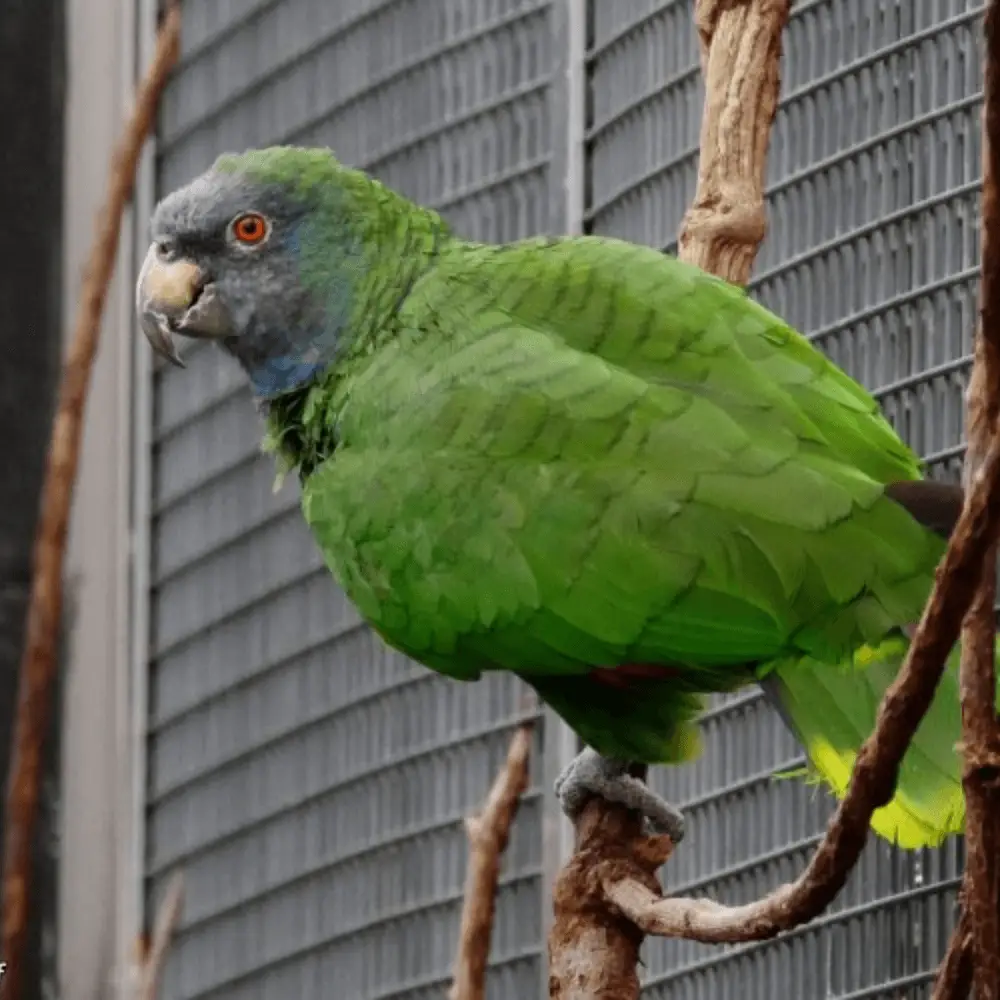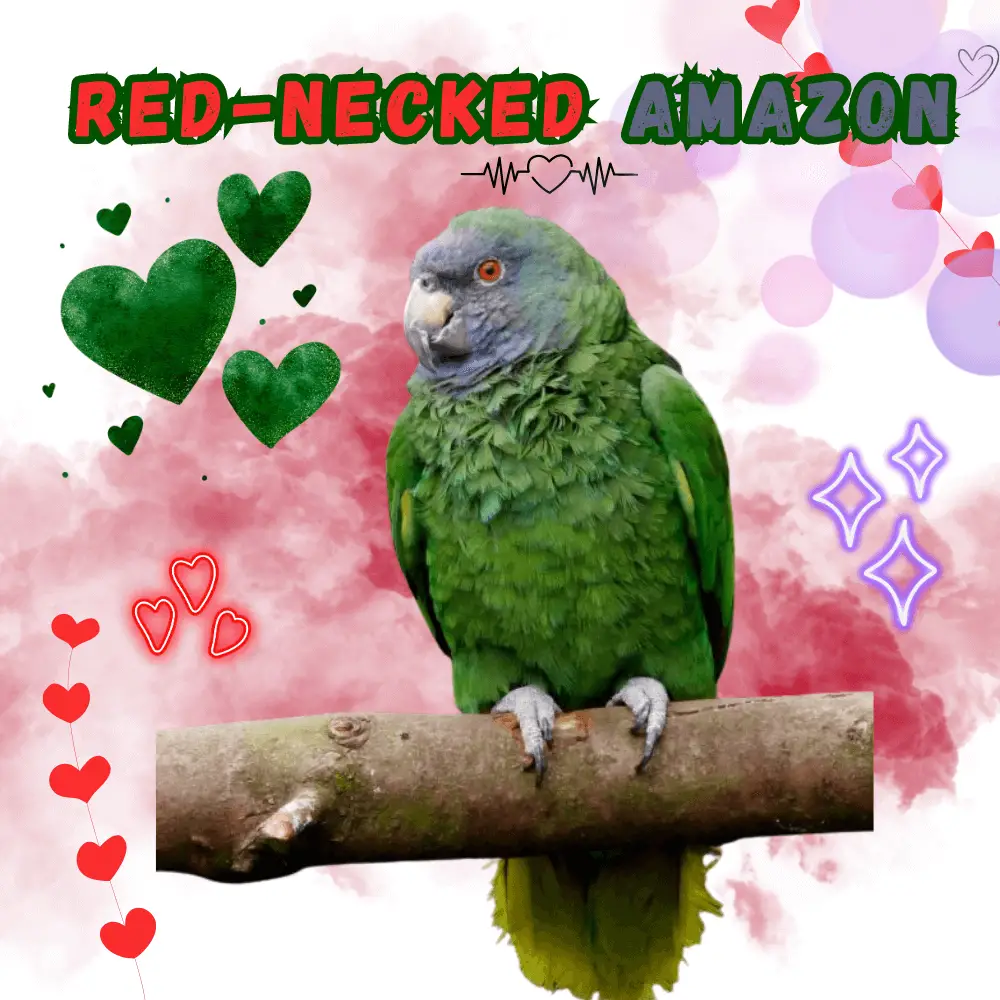Red-necked amazon: 40cm. length and 650 grams. (Amazona arausiaca) has the lores, forecrown, front crown, and orbital area Yes upper cheeks, bright blue; rear of crown, nape, and neck sides, margins green with dark blue or blackish.
Coat, back Yes collars, green with narrow, dark edges that give a subtle forbidden effect. wing covers green; carpal tunnel edge yellow-green. Primary green with blue tips; the three secondary external, red at the base, yellow and blue at the tip; four secondary yellow and blue tips. The remaining secondary ones are green. Under the wings, the coverts green; bluish flight feathers.
Chin and upper throat , blue; the bottom throat Yes, sometimes, upper chest region, with bright red resizable piece; remaining chest and belly, Green; under tail-coverts, yellow-green. Tail light green in the center, their Feathers foreign tip yellowish green and red markings on the base of the internal networks. Horn-color beak; orange irises; gray legs
Both sexes are similar . It is believed that the immature It is similar to the adult, but with brown irises . The young chicks They are significantly smaller than adults during their first year.
- Order : Psittaciformes
- Family : Psittacidae
- Genus : Amazona
- Scientific name : Amazona arausiaca
- Quote : ( Statius Müller , 1776)
- Protonimo : parrot arausiacus
- Origin: Dominica
- Character: Social.
- Height: 40cm.
Habitat

Red-necked amazon inhabits the montane rainforest canopy, preferring forest areas with Tabonuco trees (Dacryodes excelsa) , especially at 300–800 m (highest density is found at elevations 500–600 m) although sometimes they reported to 1,200 meters and formerly was a regular visitor (August October) to the coastal areas .
Usually in small groups or pairs ; more flocks feeding areas, outside the breeding season. Common roosting in traditional sites, for example in large trees Dacryodes excelsa or Sloanea berteriana , They use from year to year (but not necessarily all year round).
Reproduction
Nests in large tree cavity with most nests reported in Dacryodes o Presence . Breeding season February-June. low productivity probably just one clutch every two years and usually only one young per nest.
Food
The diet she includes fruits of Dacryodes excelsa , Symphonia globuliferaLicania ternatensis , Amanoa caribaea , Richeria grandis , Simarouba amara , , Chimarrhis cymosa , Pouteria pallida , Cordia elliptica , C. laevigata , Pithecellobium jupunba , Byrsonima martinicensis , Dussia martinicensis , ormos ia monosperma , Buchenavia capitata Yes Palmas Euterpes ,egg yolks of (Anacardium occidental) Yes the fruits and buds of Lonchocarpus , also orange crops , etc. Boreholes mainly in the canopy, but also in under-canopy and occasionally level the ground. Usually it is fed in the morning and in the evening.
SOURCE: African Grey Parrot Pet
Distribution and status
Red-necked amazon It is endemic to Dominica Island in the Lesser Antilles . Formerly it spread through the mountainous interior, including the northern peninsula. Contraction’s range from around 1950 with the extant population centered Morne Diablotin (1,447 m, the highest mountain in Dominica ) which it may have always been its main strength, but whose southern slopes birds were absent from the 1992 hurricane.
small populations , supposedly, in the north of the peninsula (where they apparently reside) and in the center east of the island. They may remain in very small populations in the south. recent sporadic bird sightings in northern and eastern low-lying areas; other southern towns suggest the gradual recolonization of parts of the old range.
mostly resident but possibly (at least once) some regular seasonal foraging movements and some nomadism from November to January. Although historical accounts tell of the abundance of this species, the drastic contraction in range and population has taken place since the middle of the 20th century, with its gradual retreat into the more remote northern and eastern forests. The decline is due to habitat loss, hunting, and birdcage capture.
The small extant population is particularly vulnerable to the loss of food plants and nesting sites due to hurricane damage. Although the effects of habitat loss may have been particularly severe due to the parrots‘ preference for low-level forests (from which it was put under pressure) they tolerated any disturbance and returned to former areas of supply recently after conversion to fruit tree plantations. The hunt was probably the biggest threat for the seventies. Capture for the local pet trade now under control due to a successful education campaign.
The population in 1977 was at least 350 birds (probably), but halved by the effects of hurricanes between 1979 Yes 1980. some recovery since then estimated 350 birds 1990 and evidence of further increases to over 500 in 1992. The remaining habitat is partially protected in the Northern Forest Reserve, but nearby areas of critical conservation importance are not included. Fully protected by national legislation.
Endangered

• Current IUCN Red List Category : Vulnerable.
• Demographic trend: Increasing.
• Population size: 850-1000.
- Rationale for Red List Category
The conservation measures It has contributed to this species to recover a declining population by 1980. still assessed as vulnerable because its population is still very low and its range of small extent and limited to a single island. However, if the future of available habitat decreases, could be reclassified as endangered .
- Population justification
The most recent population estimate is 850-1,000 mature individuals (PR Reillo Slightly. 2012), more or less equivalent to 1,200-1,500 total individuals .
- Justification trend
The population size increased to perhaps only 150 birds in 1980, possibly even 1,200 birds currently, based on recent surveys and density estimates ( PR Reillo in some. 2016 ). There are no new data on population trends, but the species is believed to be still on the rise.

